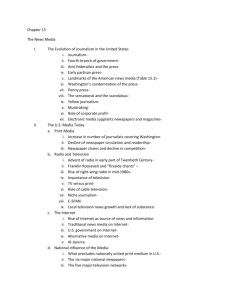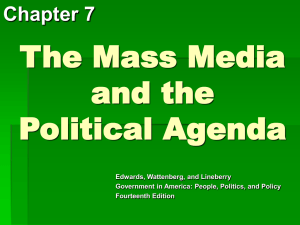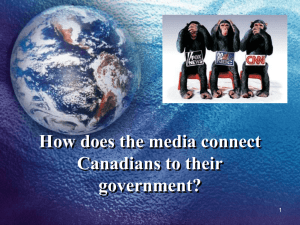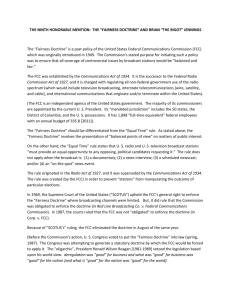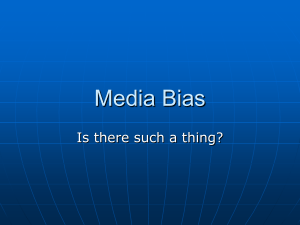Chp 15 The Media
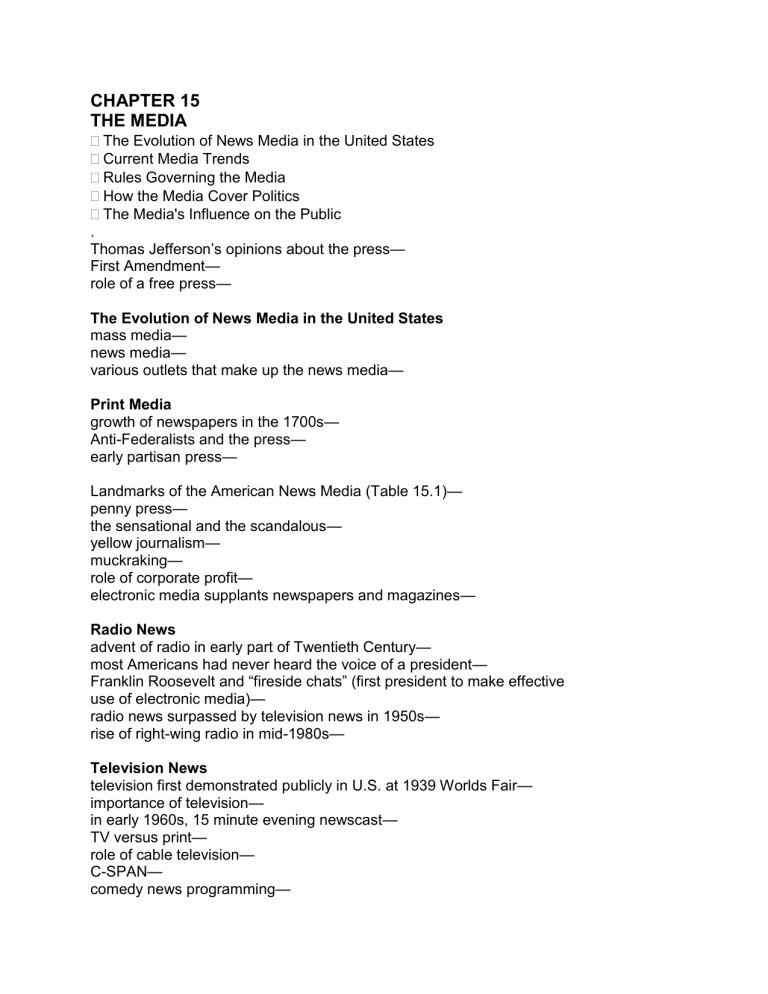
CHAPTER 15
THE MEDIA
The Evolution of News Media in the United States
Current Media Trends
Rules Governing the Media
How the Media Cover Politics
The Media's Influence on the Public
.
Thomas Jefferson’s opinions about the press—
First Amendment
— role of a free press —
The Evolution of News Media in the United States mass media — news media — various outlets that make up the news media —
Print Media growth of newspapers in the 1700s —
Anti-Federalists and the press
— early partisan press —
Landmarks of the American News Media (Table 15.1)
— penny press — the sensational and the scandalous — yellow journalism — muckraking
— role of corporate profit — electronic media supplants newspapers and magazines —
Radio News advent of radio in early part of Twentieth Century — most Americans had never heard the voice of a president
—
Franklin Roosevelt and “fireside chats” (first president to make effective use of electronic media) — radio news surpassed by television news in 1950s — rise of right-wing radio in mid-1980s
—
Television News television first demonstrated publicly in U.S. at 1939 Worlds Fair
— importance of television — in early 1960s, 15 minute evening newscast —
TV versus print — role of cable television
—
C-SPAN — comedy news programming
—
The Daily Show —
The Colbert Report parodies The O’Reilly Factor —
The New Media the Internet —
ARPANET — use of Internet in 2000 and 2005
— rise of Internet as source of news and information
— traditional news media on Internet — heavy users of online news sites and newspaper readership —
U.S. government on Internet
— foreign news media on Internet —
Al-Jazerra —
The News Generation Gap (Table 15.2)
—
Current Media Trends print media — broadcast media
— new media —
The Influence of Media Giants
Great Britain’s national newspapers—
United States’ national newspapers— networks
— affiliates
— wire services — national news magazines —
Web-based magazines
—
Media Consolidation private ownership of the media in the United States
— monopolies — potential risks of media consolidation — competition
— competing daily newspapers in 1923 and 2005
— independence and networks —
Clear Channel —
Increasing Use of Experts what influences use of experts — what impact experts have on shaping American’s views— fairness and reliability of experts?
—
Narrowcasting narrowcasting
—
FOX News —
Main Source of Campaign News by Party Affiliation (Table 15.3)
— minority news programming —
Christian conservative news programming — news to confirm preexisting views
— polarization —
Public Discontent with the Media political bias
— perception of political bias by party affiliation —
2005 survey by Pew Research Center for the People and the Press — credibility of broadcast news outlets
— trusted news anchors —
9/11 and shifts in public’s attitude toward the media— watchdog role
— majority’s belief regarding media’s influence—
Technological Innovation technology’s effect on the flow and dispersal of news— information misers — information misers and the news — blogs
— mainstream media’s use of blogs—
Blogs Versus Mainstream Media Internet Links (Figure 15.2) — various blogs
— future of new media
—
Rules Governing the Media
First Amendment
Journalistic Standards
Society of Professional Journalists’ “Code of Ethics”— unscrupulous actors — less obvious ethical dilemmas — pressure to get the story right versus to get the story first
— twenty-four hour news cycle
— media critics hired by some major newspapers —
Center for Media and Public Affairs
— conservative Accuracy in Media (AIM) — liberal Fairness and Accuracy in Reporting (FAIR) —
Government Regulation of the Electronic Media two reasons for unequal treatment of print and broadcast media —
1996 Telecommunications Act —
FCC and 2003 regulation changes
—
1)
2)
3)
4)
2003 changes by FCC allowed media corporations to own more of different kinds of media in a given market — many in Congress opposed FCC changes, arguing more, not less, media diversification needed — opposition to deregulation by FCC —
Congress passes a compromise measure in July, 2003
—
Content Regulation content regulation — equal time rule
—
2000 FCC rules and court decision on requiring broadcasts to give candidates chance to respond to personal attacks and political endorsements by a station
— fairness doctrine —
Red Lion Broadcasting Co. v. FCC (1969) —
Reagan’s FCC abolishes fairness doctrine in 1985—
Reagan veto of fairness doctrine bill
— proponents and opponents arguments regarding fairness doctrine —
Communications Act of 1934 —
Internet Service Providers (ISP)
— net neutrality —
Efforts to Regulate Media Practices prior restraint —
New York Times v. U.S. (1971) —
Pentagon Papers
—
1991 Gulf War and military’s isolation of reporters—
“Vietnam Syndrome”—
2003 Iraq invasion and “embedded” journalists— embedded journalists
— regulation of broadcasters in Britain —
Official Secrets Act of 1911 (Great Britain) —
D-notice
—
How Much Freedom Should the Press Be Allowed?
—
How the Media Cover Politics print reporters
— increase in number of print reporters accredited at U.S. Capitol since
1983
— increase in coverage of presidential campaigns — journalists accredited as daily White House correspondents —
How the Press and Public Figures Interact press release — press briefing
— press conference
— on background — deep background — off the record
— on the record — protecting confidentiality of sources —
Judith Miller in 2005
— media manipulation by politicians
— campaign consultants hired by politicians and media research — politicians by-passing national news media — libel
—
New York Times v. Sullivan (1964) — actual malice — effect of actual malice rule
—
Covering the Presidency first among the three equal branches of government in coverage
— reasons for focus on president over Congress and the courts
—
Franklin D. Roosevelt, press conferences, and the bully pulpit —
Presidential Press Conferences (Figure 15.3) — role and history of presidential press secretary
— conflict between reporters and White House over what becomes news —
Tony Snow — negative coverage of presidency
—
George W. Bush and reluctance to face the press —
George W. Bush tries to control his image —
“Mission Accomplished” image symbolizing Bush failures—
Covering Congress why it is difficult for news media to survey and cover Congress — size of congressional press corps
— news media focuses on three groups in covering Congress —
1)
2)
3) negative coverage of Congress —
C-SPAN coverage of Congress — coverage of investigative committee hearings:
McCarthy —
Enron and WorldCom
—
Abu Ghraib —
Covering the Supreme Court media vacuum surrounding Court — television in the Court — reasons for Court’s reticence to allow cameras in— audio recordings
— number of reporters covering the Court full-time — reasons the amount of coverage of Court-related stories diminishing —
American’s knowledge about the Court—
1)
2)
3)
4)
The Media’s Influence on the Public
Media Effects effect of media on the public
— what limits ability of news media to sway public opinion?
— as party identification declined, media influence increased — when media especially affects public opinion
— media effects — how media-influenced changes might occur:
5)
Media Bias
“biased reporting”— research suggests why candidates might charge media with bias — why are journalists biased?
— claims of liberal bias in 1980s and 1990s
— corporate bias — corporate interests and corporate broadcast ownership — lack of news media skepticism over Iraq
— one-sided media
—
“fair and balanced” self-applied slogan versus FOX News obvious conservatism — audience aware of news bias and seek out their biases
—
Objective Versus Biased Reporting —
Democrats more likely to watch CNN —
Republicans twice as likely to watch FOX News
—
Democrats and Republicans habits regarding network news, cable news,
AM talk radio, NPR, newspapers —
Partisan Bias in Media Reporting?
— ideological fragmentation of media
— political journalists desire for a good campaign story (usually negative) —
news media prefers covering horse-race components of campaigns rather than public policy issues — effect of journalists’ personal feelings about a candidate— celebrity status of news reporters
— revolving door between politics and news media —
Practice Tests
MULTIPLE CHOICE QUESTIONS
1) Inclusion of a provision to protect the freedom of the press in the final version of the Constitution was demanded by a. George Washington. b. the Anti-Federalists. c. the Federalists. d. Thomas Jefferson.
2) The Founders placed such importance in the value of a free exchange of ideas in a democratic society that, despite the written assaults many received from the press, the Founders guaranteed freedom of the press in a. the Preamble to the Constitution. b. Article I of the Constitution. c. the First Amendment of the Constitution. d. the Fifth Amendment of the Constitution.
272
3) Approximately percent of adult Americans read a daily newspaper. a. 10 b. 25 c. 50 d. 90
4) Most newspapers today are owned by chains, which a. reduces the diversity of editorial opinion available. b. results in the homogenization of the news. c. caused a drop in the overall level of competition. d. All of the above.
5) The first president to make effective use of the electronic media to push his programs and assuage the fears of the American people during a time of national crisis was a. Franklin D. Roosevelt. b. Harry S Truman. c. Dwight D. Eisenhower.
d. John F. Kennedy.
6) According to researchers, which one of the following age groups is the least likely to have read a newspaper yesterday? a. 18-29 b. 30-49 c. 50-64 d. 65+
7) If you talk to a reporter and want not to be quoted or used as a source, yet you want the reporter to use the material you give her, you need to tell the reporter up front that you are talking a. off the record. b. on shallow background. c. on background. d. on the record.
8) The first president to have a press secretary was a. Herbert Hoover. b. Franklin D. Roosevelt. c. Dwight Eisenhower. d. John F. Kennedy.
273
9) The branch of the federal government receiving the most coverage by the news media is the a. judiciary. b. Congress. c. presidency d. bureaucracy.
10) The Internet began as a project for a. the Department of Defense. b. the Time-Warner Corporation. c. the Postal Service. d. AT&T.
11) In what 1964 case did the Supreme Court rule that for public figures to claim libel there must not only be a defamatory falsehood but also actual malice, making it much harder for public figures to prove libel? a. Burnett v. National Enquirer. b. New York Times v. Sullivan. c. Hamilton v. Graber. d. Newman v. The Globe.
12) The inception of the actual malice proof requirement in libel cases involving public figures had the effect of a. enhancing First Amendment press protection. b. reducing the expense of defending libel claims. c. allowing editors and reporters to expend more time and energy on libel claims. d. increasing the number of libel suits filed.
13) Journalists, being people, reflect bias. The bias(es) most commonly exhibited by
the news media is/are a. personal biases against or for individuals. b. competition —fear of missing a good story. c. corporate bias. d. All of the above.
14) The fairness doctrine required broadcasters to cover events and present contrasting views on important government issues. The fairness doctrine a. is still in effect. b. is also called the equal time rule. c. was in effect from 1949-1985, but eliminated during the Reagan administration. d. was proposed by Congress but never passed.
274
15) In the 1971 case of New York Times v. United States , the U.S. Supreme Court held that prior restraint a. could not be imposed by newspaper editors. b. could be applied against broadcast media but not the print media. c. could be imposed on the publication of the Pentagon Papers. d. could not be imposed by the government except under extremely rare and confined circumstances.
TRUE/FALSE QUESTIONS
1) The first U.S. president to condemn the press for its coverage of his presidency was Franklin D. Roosevelt.
2) Television was first demonstrated in the United States in Washington, D.C., in
January of 1953 at the inaugural of President Dwight D. Eisenhower.
3) William Randolph Hearst and Joseph Pulitzer were known for championing sensationalized, oversimplified news coverage.
4) The modern press is less partisan and more concerned with corporate profit than the press in the eighteenth and nineteenth centuries.
5) Television is the most popular source for news today.
6) Coverage by C-SPAN of congressional proceedings and major political events is far more glitzy and filtered than coverage offered by broadcast and cable networks.
7) Politicians have found that they have little ability to influence or manipulate the news media.
8) More men than women seek political content online.
9) The news media affects the public more by what events it chooses to cover as opposed to how it covers events.
10) The U.S. Constitution prohibits all regulation of the news media.
COMPARE AND CONTRAST yellow journalism and muckraking
American and international approaches to the mass media
print press and electronic media broadcast news networks and cable news networks media coverage of the president, Congress, and judiciary on background, deep background, off-the-record and on-the-record statements broadcasting under the fairness doctrine and broadcasting without the fairness doctrine
ESSAY AND SHORT ANSWER QUESTIONS
1) Discuss the functioning of the U.S. press from its establishment in 1690 through the nineteenth century.
2) Discuss the impact of media mergers on the diversity of information available to
American citizens.
3) When covering Congress, which figures do the news media tend to cover and why?
4) What effect did the repeal of the fairness doctrine in the mid-1980s have on broadcasting and on American politics?
5) What kind of influence do the news media have on the public's attitudes and opinions?
6) The news media today consists of a number of types of media. What are they and how do they differ? How are they similar? What incentives do they operate under and how do they decide what to use and what not to use?
7) Compare and contrast the ways in which the media cover the Congress versus the presidency.
8) Are the media biased? How? Discuss fully and give examples.
9) Discuss the ways in which government regulates and censors the media.
10) How have the news media changed in the last two decades? What have been the impacts of these changes?
6) a
7) b
8) a
9) c
10) a
11) b
12) a
13) d
14) c
15) d
ANSWERS TO STUDY EXERCISES
Multiple Choice Answers
1) b
2) c
3) c
4) d
5) a
True/False Answers
1) F
2) F
3) T
4) T
5) T
6) F
7) F
8) T
9) T
10) F
